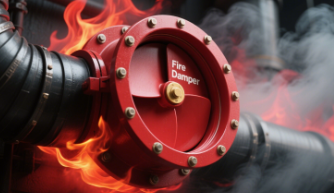Fire dampers serve as protective devices that inhibit the movement of fire and smoke within a building’s ductwork. Their proper functioning is essential for protecting life and enhancing the safety of a building. In this blog, we will discuss the purpose of fire dampers, the various types available, and factors to consider for optimum installation and upkeep.
Fire Dampers Explained
Fire dampers are meant to prevent smoke or fire from spreading through vertical and horizontal ductwork in a building. They are designed to close automatically when a fire alarm is activated, blocking ductwork so flames cannot move to different sections of the building. Fire dampers are a vital part of a fire protection system as they help to safeguard both life and a structure’s property.
Fire Dampers Types
Fire dampers are classified into different sub-categories each meant for specific applications. The most notable include:
-
Manual Fire Dampers: Found in places determined to be fire hazards, these dampers are closed manually.
-
Automatic Fire Dampers: These respond to fire conditions by automatically reacting to fires via thermal sensors that close the damper when the temperature exceeds a certain level.
-
Combination Fire and Smoke Dampers: These structural devices stop fires and smoke from passing through the duct system which is essential for tall buildings and complex structures.
Importance of Fire Dampers Installation
Proper installation is the primary factor that influences the effectiveness of fire dampers. Dampers, for instance, are meant to close off fire and smoke and if they are installed incorrectly, gaps are created that allow fire and smoke to defeat the very protection that dampers are supposed to provide. Therefore, certified professionals help mitigate the risks and improve the safety of the building.
Fire Dampers Maintenance and Inspection
Effective maintenance involves checking, testing, and making certain that the dampers are unobstructed. It is essential to carry out inspections on such devices to guarantee they function as expected. With fire dampers, exposing such devices to outside conditions that may hinder functionality warrants proper maintenance and strict schedules for inspection, and detailed log of repairs and assessment is essential. Fire safety training for the relevant staff also strengthens the fire safety systems.
Anticipated Innovations and Industry Developments
With the advancement of technology and the introduction of new building codes, the fire damper sector is undergoing considerable transformation. New innovations, such as smart fire dampers with IoT capabilities, enable the smart fire dampers to be monitored and provide alerts in real-time. Strides in technology of this nature can enhance building safety and safety during emergencies. Moreover, an increase in safety and regulatory compliance is driving the need for better quality fire dampers, forcing manufacturers to upgrade to industry standards earlier and keep an edge in the competition.
To summarize, dampers are an essential fire safety gadget incorporated in extinguishing systems for safety as well as the protection of the building. Building owners need to appreciate the compliance issues and the installation, and effective safety issues so their occupants can be effectively protected and guarded. Manufacturers need to keep in mind the regulatory needs of the fire dampers industry to enable the building to keep high standards.

